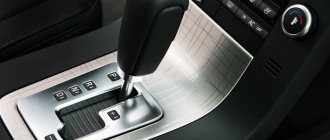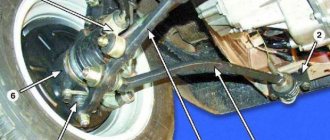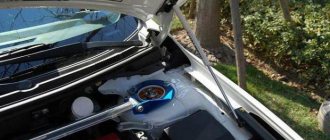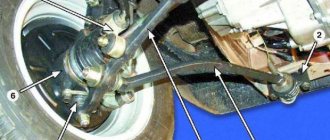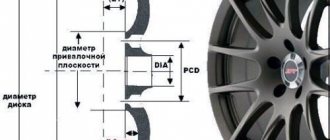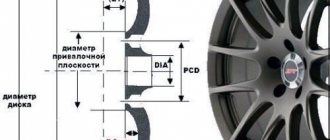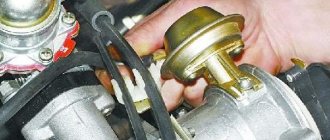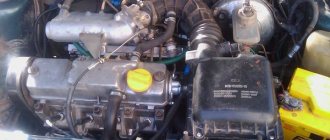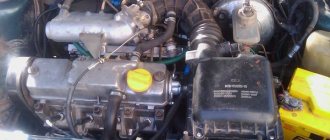Shock absorbers are key components of a car's suspension.
Without them, driving a car is not only uncomfortable, but also dangerous. The task of shock absorbers is to dampen the vibrations of springs that occur when driving on the road. In the absence of shock absorbers, it would take some time for the springs to “calm down” after the next bump; accordingly, at this moment the car would shake and sway. Such behavior of the car will quickly lead to dire consequences, for example, a breakdown of the muffler, underbody, damage to the suspension or an accident due to loss of controllability. One of the problems that can arise with shock absorbers is the appearance of smudges on them. If the shock absorbers are leaking, you can ride on them, but you should already think about replacing them.
Why did the new shock absorber leak?
There are times when you buy new shock absorbers for your car, come to a service station, they remove the old shock absorbers on your car and install new ones.
Together with them they install a new service kit (boots and shock absorber bumpers), and you drive away in your car with new shock absorbers installed. With the old shock absorbers, you felt that the car was somehow “sluggish” and “shaky.” I didn’t keep the road on a “washboard”, the extraneous knock on a not entirely smooth road (which in our city, and not only in our city, is about 99%) was just “sick”... You stopped at a service station. This service station was recommended to you by your good friends - they get their car repaired here. True, your car is a different brand than your friends. But, according to most car owners, the cars are the same. They (cars) all have four wheels, the wheels are round, and all cars are controlled by a steering wheel.
So, after installing new shock absorbers,
– we immediately felt the difference in driving. Everything became different. And immediately your car became somehow “knocked down”. Something in it has stopped annoyingly knocking, as they explained to you - this knocking was caused by wear of the shock absorber rod in the “working comfort zone”. This doesn't tell you much. You are happy with the result: although the shock absorbers are not cheap, the result is obvious.
But... After some 20-30 kilometers, it began to seem to you that the car began to “knock” again and stopped holding the road, returning to its condition, which was before replacing the shock absorbers and bumper guards. You begin to think that the reason is that you bought non-original shock absorbers. “Maybe I should have put on the original?” – you begin to think.
The next day, you come to the service station where your shock absorbers were changed. Tell us your thoughts about original and non-original shock absorbers. They listen to you carefully, say: “Perhaps,” and drive the car onto a lift for diagnostics.
When you lift the car, the defect immediately becomes obvious! Both shock absorbers leaked... There was some kind of smile on the faces of the mechanics. But this smile gives way to an incomprehensible grimace of bashful horror when they remove the shock absorber from the car and expose the shock absorber rod, removing the bumper boot from it... The shock absorber rod has traces of scuffing. Moreover, these scuffs on the rod are not longitudinal (in the direction of shock absorber operation), but transverse. It’s as if someone specially took and “pulled” the rod with some kind of tool, but it’s not clear why?!
Later it turns out that the careless mechanic who changed the shock absorbers had no idea how shock absorbers are changed correctly, as described in the technical literature. Later, of course, the owner of the service station will be forced to apologize to you and eliminate the defects in the work performed by his employee - at the expense of the service station. You no longer care about the fate of that careless mechanic; you want to leave the service station faster with a repaired car.
What can we advise to avoid getting into such situations? Defects at work and careless employees are found in many areas of human activity. “He who does nothing makes no mistakes,” the proverb tells us.
But, still: trust the repair of your car only to professionals. Buy spare parts only in a car store that you have verified and where you liked both the level at which you were served and the professionalism of the employees.
Share link to:
List of articles »
m. Kharkiv Telephone: +380(67) 57-19-19-7 +380(57) 716-42-44
The shock absorber is leaking, what should I do?
Greetings, dear motorists! And again, we continue to study individual systems, components and parts of your car.
Quite a lot of motorists, in particular beginners, believe that the purpose of batteries is only to provide comfort while driving. This is true, but it is just one of the functions. How amazed novice motorists are when they don’t pay attention to leaking shock absorbers, and as a result they end up in a ditch. You wouldn't wish this on anyone!
What to do if the shock absorber starts to creak
One day during a trip, you heard that the rear or front shock absorbers began to creak. This means that it’s time to carry out not only diagnostics of the car’s suspension, but also diagnostics of the shock absorbers. If the shock absorber squeaks, this is a warning for you. When diagnosing the suspension, visually inspect the shock absorbers. If, upon inspection, you find that the shock absorber is leaking, then you should immediately repair or replace it.
Can you guess why? Yes, it’s simple, in the “best” case, only the suspension will suffer, in the worst case, you can become involved in an accident at any moment. How do you like this prospect? If you close your eyes to this, you will spend even more money, not only repairing the shock absorber, but also repairing the suspension. We advise you not to be lazy and visually inspect the shock absorbers systematically. Moreover, there is nothing complicated about it - you turn the wheels and make sure that the shock absorber is not leaking, that everything is normal. Most novice motorists, when diagnosing the condition of shock absorbers, make hasty conclusions about the malfunction of the shock absorbers when they see oil deposits on them. However, there is nothing wrong with this, this is a completely normal condition. But if you notice oil leaks, then replacement or repair certainly cannot be avoided.
What to do if the shock absorber strut leaks: consequences
Shock absorbers leak due to their design: they are a cylinder that runs in a special sleeve. A special piston moves through a mass of oil or gas (or both at the same time - a combined type). The rod is fixed on it. Thanks to which there is no compression or stretching. The oscillation process itself takes place thanks to the jets.
They are small in size. It is for this reason that the rod moves a short distance, slowly. To prevent oil leakage, the gas outlet from the shock absorber in its upper part is equipped with special seals and gaskets. Thanks to them, the filling of the sleeve does not go beyond its limits. However, with severe wear, oil begins to gradually ooze out. This is due to the following details:
The presence of leaking oil indicates that the part is gradually failing or has already failed! A leak indicates that the shock absorber has already exhausted its service life. It needs repair or replacement. A leak is an obvious sign of a suspension problem. Many people ask the question: is it possible to operate a car in this condition? There is no clear answer to this.
For example, if only one rack is out of order, then it is possible to use the car for a short time. But if the struts fail in pairs (two in front or behind), then it is better to stop driving until they are replaced. Because otherwise the car will “toss” along the road like on a roller coaster. Moreover, regardless of the speed of movement. Sudden maneuvers can lead to an accident. Moreover, replacement is best done immediately when the above symptoms occur.
- if one pillar is leaking, then it is possible to use the car for a while without heavily loading the body;
- If 2 or 3 struts are leaking, you need to drive extremely carefully, at low speed and only to the nearest car service center!
It will be useful: Which H1 low beam lamps are better?
When choosing shock absorbers you need to be careful. One of the compromise solutions in terms of price-quality ratio today is KAYABA.
Replacing or repairing a shock absorber - the choice is yours
The most common reason that the shock absorber began to leak is the loss of tightness. And all this because the operation of our vehicles takes place practically in combat conditions. However, this does not make it any easier. We need to act immediately. You make the decision whether to repair or replace shock absorbers yourself, relying on the following factors: – it is better to buy a new shock absorber if the cost of repairing and buying a new one is not very different; – provided that you have some skills, you can try to repair the shock absorber yourself using a repair kit.
Video - replacing the shock absorber
Pay attention to this point - most shock absorbers are currently non-separable parts. So, keep in mind that if a car repair shop offers you to restore a shock absorber, then this is a dubious idea, and it is unlikely to be profitable. You are not changing a light bulb, but a part that is responsible for your safety.
Based on practice, we can conclude that a restored shock absorber does not last that long, and then will require repair again. Therefore, if a problem has already emerged - the shock absorber is leaking, it is optimal to replace the shock absorbers. If the shock absorber is restored, it means it will last 5 thousand km, no more, but a new one, taking into account its quality and normal use of the car, will last 5 years, exactly.
Read the Repair and Operation Manual for your car; it should indicate what type of shock absorbers are installed on your car by the manufacturer. If shock absorbers with pumping are installed, then you only need to plug the hydraulic fluid pipes, and that’s all the repairs are. You can repair hydraulic or gas shock absorbers yourself. However, for this you will need special equipment, which you may not have in your garage. In this case, you have a direct route to specialists at a car service center, and this is again a minus in the budget. Practice shows that a leaking shock absorber is best replaced with a new one - this is the only correct solution.
I wish you success! Let such a problem as creaking shock absorbers be familiar to you only in theory!
see also
How to check a support bearing
- 108 1 178k
Strut support bearing
- 76 1 88k
Which shock absorbers are better
- 152 3 141k
How does a car's shock absorber work?
- 4 0 23k
Shock absorber (car shock absorbers)
- 0 0 18k
Shock absorber malfunctions greatly affect the car's behavior on the road. In particular, the car body “dives” during acceleration and braking, the braking distance increases, rolls heavily during maneuvering and sways when driving over uneven surfaces.
There are obvious and hidden signs of faulty shock absorbers. Obvious ones include the appearance of oil leaks (wear of the oil seal and/or rod), but there are more hidden ones, for example, aging of the oil, deformation of the valve mechanism plates, wear of the piston seal and the inner walls of the working cylinder. To avoid unpleasant consequences, you need to identify the faulty shock absorbers in time.
Management, operation
Indirect signs of faulty shock absorber struts - problems when operating the machine:
- the wheels “yaw” when driving over uneven surfaces;
- there is a swing in different directions - for no apparent reason;
- lack of normal feedback on the steering wheel.
It must be remembered: such signs of faulty struts are present not only at high speeds. But even if the speedometer is much less than 60 km/h. It is important to remember that deterioration in controllability is one of the first signs of a malfunction not only in the steering system. But also shock absorbers.
Signs of faulty shock absorbers
There are two types of signs that a shock absorber has completely or partially failed. The first type is visual. In particular, they can be identified by visual inspection of the shock absorber. The second type of signs includes changes in the behavior of the car in motion. Let us first list the signs related to the second type, since first of all it is necessary to pay attention to how the behavior of the machine has changed, in particular:
- Rocking when braking and accelerating . If the shock absorbers are working properly, then even with sharp braking the car should swing back no more than once, after which the shock absorber should dampen the oscillatory movements. If there are two or more swings, this is a symptom of partial or complete failure.
- Roll when maneuvering . Here the situation is similar; after exiting a sharp roll when entering a turn, the body should not sway in the transverse plane. If so, the shock absorber has similarly failed.
- Increased braking distance . This factor is due to the same swing during braking. That is, during prolonged braking, the shock absorber does not dampen vibration, and the car periodically lowers and raises the front part of the body. Because of this, the load on the front wheels is reduced, which reduces braking efficiency. The braking distance is especially longer for vehicles equipped with an anti-lock brake system. This is because the rear end rises and the ABS reduces the brake line pressure. Also, the braking distance increases when braking on uneven roads.
- The car does not “hold” the road . In particular, when the steering wheel is installed in a straight position, the car constantly pulls to the side. Accordingly, the driver must constantly steer in order to align the trajectory of movement.
- Discomfort when driving . It can manifest itself in different ways. In particular, some drivers and/or passengers feel discomfort from the rocking of the car when driving long distances; people suffering from “sea sickness” (the official name is kinetosis or motion sickness) can feel motion sick. This effect is a typical symptom of faulty rear shock absorbers.
What is the effect of a faulty shock absorber?
The use of worn shock absorbers can not only cause discomfort while driving, but also cause a real danger when driving the car. So, possible problems associated with a faulty shock absorber:
- Reduced wheel grip. In particular, when the car rocks, the clutch will have a variable value.
- Increased braking distance, especially on vehicles with an anti-lock braking system (ABS).
- Some electronic systems of the car, such as ABS, ESP (exchange stability system) and others, may not operate correctly.
- Deterioration in vehicle handling, especially when driving at high speed.
- The appearance of “hydroplaning” when driving on a wet road at low speeds.
- When driving at night, constant rocking of the front of the car can cause the headlights to blind oncoming drivers.
- Discomfort when driving. This is especially true when driving long distances. For the driver, this threatens increased fatigue, and for people prone to seasickness, this is dangerous due to motion sickness.
- Increased wear of tires, rubber bushings, silent blocks, bump stops and springs. and other elements of the car suspension.
Causes of shock absorber malfunction
The causes of failure are usually natural factors, including:
- Aging of shock-absorbing fluid (oil). Like other technological fluids in a car, the oil in the shock absorber gradually gains moisture and loses its performance properties. Naturally, this leads to the fact that the shock absorber begins to work harder than it worked before. However, it must be understood that fluid aging does not happen overnight, with the exception of a rupture of the seal on the shock absorber body.
- Torn seal. In particular, the sealing of the piston and the inner walls of the working cylinder. The oil seal can rupture due to external factors or simply due to the aging process. It, like any rubber seal, becomes tanned over time and begins to leak liquid. Because of this, oil leaks from the shock absorber, as well as moisture from the outside entering the oil, which leads to a deterioration in its performance.
- Deformation of the valve mechanism plates. This process is also natural and occurs on an ongoing basis, albeit at different speeds. Thus, the rate of deformation depends on two main factors - the quality of the shock absorber (the quality of the metal of the plates) and the operating conditions of the machine (naturally, a significant impact load leads to premature deformation).
- Gas leak. This is true for gas-filled shock absorbers. The idea here is the same as for oil-filled devices. Gas here performs a damping function, and if it is not there, then the shock absorber will not work.
- Failure of silent blocks. They wear out due to natural reasons, losing their elasticity and performance. These components are practically not subject to repair, so if they fail, they simply need to be replaced (if possible, or the shock absorbers must be completely changed).
Why did the shock absorber leak?
From a technical point of view, a shock absorber is perhaps one of the key parts of a car’s suspension. If all other components of the chassis are diagnosed simply, using installation, then a full diagnosis of the shock absorber should be carried out only on a special stand. Despite this, the level of shock absorber production today is so high that the percentage of defects in the final product does not exceed 0.5%. So why do shock absorbers leak? Sellers have a firm and unambiguous answer to this: the cause of hydraulic fluid leaks in the winter season is primarily due to improper operation.
“The comfortable operating temperature range for hydraulic (gas-oil) shock absorbers is from -25°C to +30°C. In this range, shock absorbers operate without significant overloads, but this does not mean that they are not designed to work in a lower range, says Sales Director Maxim Legushev. — I know that Sachs shock absorbers are tested at the factory at an air temperature of -43°C. And even in such difficult conditions they demonstrate excellent performance. It is only important to follow the operating rules."
Warming up the suspension
As a matter of fact, there is only one rule for using shock absorbers in cold weather - they must be given the opportunity to warm up in a gentle operating mode. The engine can be warmed up before driving, but the chassis cannot. Accordingly, it needs to be warmed up in the first minutes of movement.
“Warming up the shock absorber means that after parking in the cold, you should start moving slowly and carefully, avoiding holes and obstacles, so that the amplitude of vibration of the shock absorber rod is minimal. In this mode, the hydraulic fluid will gradually reach operating viscosity and temperature. The likelihood of damage to the shock absorber and leakage of hydraulic fluid from the shock absorber will be minimized,” explains KYB brand manager Evgeniy Lyakhovich. “Every motorist must decide for himself how much time to spend warming up the suspension, based on the ambient temperature, the length of time the car is parked and a subjective assessment of the suspension’s performance.”
Maxim Legushev adds that any more or less experienced motorist understands perfectly well when the shock absorbers have already warmed up:
“The car begins to smoothly handle all the bumps, the suspension becomes softer and operates quieter. Everyone knows this, but apparently, in a hurry, many do not give the shock absorbers a chance to warm up and end up with a problem such as a hydraulic fluid leak.”
Not every leak is dangerous
The mechanics of the process are as follows. When exposed to low temperatures, hydraulic fluid thickens and is less easily pumped through the valves. If you force the shock absorber to compress strongly at this moment, then some of the liquid simply will not be able to pass through the channel and be squeezed out through the shock absorber seal.
“However, not every leak of hydraulic fluid from a shock absorber is critical for its performance. Small leaks of liquid through the seal or sweating in the area of the rod do not always lead to a deterioration in the performance of the shock absorber. Most likely, after this the shock absorber will damp normally and dampen body vibrations,” notes car service manager Viktor Volodyushkin.
It will be useful: My car battery is dead, what should I do?
In general, when designing shock absorbers, the manufacturer takes into account the likelihood that over time the amount of liquid in the chamber will decrease.
“This is done on purpose, since the hydraulic fluid is one way or another gradually consumed to lubricate the rod. A slight fluid leak will not affect the car's handling in any way. The quality of handling all road irregularities will also remain quite high,” confirms Maxim Legushev.
According to Viktor Volodyushkin, hydraulic fluid leakage becomes critical only after inert gas leaves the shock absorber, which serves as additional support and prevents foaming of the fluid when passing minor road irregularities. Such damage to the strut immediately becomes noticeable when moving. The car begins to sway violently, it takes more time to dampen vibrations, and road traction deteriorates.
Who will give the guarantee?
Determining a warranty case is the task of the service station that installs the shock absorbers.
“As you know, under the KYB service program, authorized service centers are required to carefully check the condition of the suspension when installing shock absorbers. The technician decides what the warranty period will be. The maximum warranty period is two years or 70,000 km. If the shock absorber fails during this period, then the service station where the installation was carried out is required to identify the cause. If the cause of the defect is a manufacturing defect, the shock absorber will be replaced with a new one, explains Evgeniy Lyakhovich. — True, if a motorist with a frozen car at -30°C stages a rally on the road without warming up the suspension, then such a case is unlikely to be recognized as a warranty, since the parts of the car’s chassis are simply not designed for this, and the likelihood of damage to the shock absorber in this case is no lower than the chance of tearing anthers and silent blocks.”
How to increase frost resistance?
This question is probably of interest to many Siberians today, who, after the extremely cold January, had to shell out several thousand rubles to replace the racks. Well, if the problem is so acute for you, then you can look on the market for tuning versions of shock absorbers, the design of which uses frost-resistant sealing rings. The vast majority of motorists are confident that the frost resistance of a shock absorber strut depends entirely on the properties of the hydraulic fluid. In fact, the resistance of the shock absorber to frost is largely ensured by the properties of the rod seal.
“I’ll give you a simple example,” says Maxim Legushev. — You drive your frozen car onto the road and immediately end up with a wheel in a hole. Part of the thickened liquid passes through the valve, and the bulk hits the oil seal. If the seal has retained its elasticity in the cold, then it will withstand this blow. If it becomes “stiff,” the liquid will flow out.”
The frost resistance of shock absorber sealing rings from the top five largest manufacturers does not raise any complaints. Some shock absorber manufacturers also produce small series of struts filled with low-viscosity and low-temperature hydraulic fluids. True, large European and Japanese companies do not do this, since the demand for such shock absorbers in the world is extremely low. So you will have to look for such a shock absorber in the model range of Russian manufacturers. In addition, one can only guess what the behavior of such racks will be in the summer, at a temperature of +30°C.
You can also replace the hydraulic fluid in your shock absorber with one that is more resistant to cold weather. True, to do this you will have to completely disassemble the shock absorber, and this is an intervention in its design, which will immediately void your warranty. No manufacturer of shock absorber struts allows them to be disassembled for any purpose.
“The position of shock absorber manufacturers on this issue is adamant. We know that in artisanal conditions, some service stations try to offer such a service, but in this case, the car owner takes all the risks upon himself,” says Evgeniy Lyakhovich.
The same point of view is expressed by other official dealers of shock absorber manufacturing companies. At the same time, experts note that if you installed a leaking shock absorber very recently (less than a year ago), then you can replace only one strut on the car’s axle. But before making such a decision, it is still better to check the condition of the second shock absorber on this axis.
How to determine if shock absorbers are faulty
Car owners are not without reason concerned about the question of how to check an oil or gas-oil shock absorber. This is due to the fact that modern shock-absorbing devices often have a more complex design than older models, which makes diagnostic measures more complicated. Therefore, ideally, they should be checked in a car service center on a special stand. However, there are a number of “garage” verification methods.
Body rocking
The simplest, “old-fashioned” method is to rock the car body. In particular, they rock its front or rear part, or the shock absorbers separately. You need to swing it strongly, but do not bend the body elements (in practice, such cases occur!). In theory, you need to achieve the maximum possible swing amplitude, then release the body and look at its further vibrations.
If the shock absorber is working properly, the body will make one swing (or one and a half), after which it will calm down and remain in its original position. If the shock absorber has a malfunction, the body will make two or more oscillations. In this case, it must be replaced.
It is worth noting, however, that the rocking method is suitable for cars with a simple suspension system, for example, the VAZ “classic” (models from VAZ-2101 to VAZ-2107). Modern cars often use complex (often multi-link) suspension, so it will dampen the resulting vibrations even with faulty shock absorbers. Therefore, with the help of body rocking, by and large, it is possible to determine two borderline states - the damper is completely out of order, or it jams during operation. It is not easy to identify the “average” states of the shock absorber using swinging.
Visual inspection
When diagnosing a problem shock absorber, be sure to perform a visual inspection. To do this, you need to drive the car into a viewing hole or lift it on a lift. You can, of course, dismantle the shock absorber, but this can take a lot of time and effort. During the inspection, be sure to check for oil smudges on the shock absorber body. You can wipe off traces of oil with a rag and leave it like that for several days. After this period, the test should be repeated.
If the car is raised on a lift, it is advisable to check the condition of the shock absorber rods. They should not show any signs of rust or damage. If they are present, then the device is at least partially faulty and additional diagnostics need to be performed.
When inspecting, be sure to pay attention to the wear pattern of the tires. Often, when shock absorbers are broken, they wear unevenly; as a rule, the main wear occurs on the inside of the tire. There may also be isolated bald spots of wear on the rubber. However, tread wear may also indicate other failures in the suspension elements, so additional diagnostics are also needed here.
If faults in the front shock absorber (strut) are checked, a mandatory inspection of the springs and upper supports must be performed. Shock-absorbing springs must be intact and free of cracks and mechanical damage.
Machine control check
If the shock absorber/shock absorbers are faulty, then while driving the driver will feel that the car is “scouring” along the road, that is, it will be necessary to constantly steer in order to keep it in the rut. When accelerating and braking, the car will sway. The situation is similar with lateral body tilts. In this case, it is not necessary to accelerate to a significant speed; the city speed limit is quite suitable for testing. In particular, at a speed of 50...60 km/h you can do sharp acceleration, braking, and snake.
Change or... repair: how and why shock absorbers are repaired
Of course, a sharp-tongued reader will say: someone who buys a car for several million can easily spend a hundred or two on racks. This is, of course, true, but only at first glance. Firstly, consider the quality of the road surface, which is far from desired, and imagine how quickly new shock absorbers installed on a car weighing more than 2.5 tons will die. Secondly, one should not discount the fact that people driving a GL500 have the ability to calculate expenses. And at the end of the virtual tour, imagine that you, the owner of the X5, are told: “Repairing one shock absorber will cost you 350 euros.” Almost 5 times cheaper! And what will be your decision after this?
We won’t talk about the design of shock absorbers: enough was said in the article about replacing struts . Today we will focus exclusively on breakdowns and their elimination.
Breakdowns
One of the most common shock absorber malfunctions is leakage of working fluid through a damaged oil seal. There are several reasons why it comes to an end, and the main one is friction. The simplest option is when the service life has expired and the sealing part has worn out. But it happens that the shock absorber begins to “sweat” or leak before reaching half of its service life.
Articles / History Softness and hardness of the suspension - what is more important for comfort? Almost every car owner is sure that a soft suspension provides comfort, while a hard one makes the car sportier and allows better grip on the road. But as in many other cases,... 87426 1 37 03/05/2015
The reason for this may be winter - or rather, frost . For example, you drove out of a warm garage somewhere, stopped to drink hot chocolate and sat for a while in a coffee shop. Due to heating and subsequent sharp cooling in the cold, grains of ice formed on the shock absorber rod. They will tear the seal on a relatively new shock absorber. In addition, death of the seal can also occur after dust and dirt get on the rod due to damage to the boot.
The rod itself is difficult to “kill,” but it moves in the guide sleeve, into which Teflon rings are, in turn, pressed. These rings, of course, wear out, and then the rod begins to experience shock loads in the contact surface. If you do not pay attention to this in time, you can break the entire guide sleeve - and this is already a disaster from the point of view of driving safety. Well, there’s nothing to say about the shock absorber bushings; they can break first. Replacing them is not a big problem, but it happens that this is simply not provided for structurally.
Piston valves are perhaps the most durable elements of the assembly: there is essentially nothing to break in them. But it happens that small particles of dirt get inside the shock absorber through a damaged oil seal and broken Teflon rings. So they can cause a number of troubles, the saddest of which is a loose valve fit. Then the shock absorber will “dangle” during the compression or rebound stroke - depending on your luck.
Gas or air that has gotten inside the shock absorber can also be a problem. This manifests itself in audible shocks from the shock absorber during its operation. The impact occurs when an air bubble passes through the valve and piston, causing the strut to suddenly sag.
Articles / Practice When it’s better not to start up: what can break down in a car in severe frost Epiphany time is the best time for the next portion of horror stories about frosts. So, it’s a frosty morning, it’s dark, but for some reason you needed to go. It would seem that when the starter, groaning, managed to... 58697 30 38 01/19/2017
How can air get into a monotube shock absorber? Yes, very simply - through a worn out sealing ring of the separating piston. It wears out gradually, so at a certain point it begins to “poison” the gas into the cavity with the working fluid. If problems with tightness are not identified in time, then regardless of whether you have a double- or single-tube shock absorber, foaming of the working fluid will occur with a loss of damping properties and a sharp increase in wear of the rubbing surfaces. If the shock absorber is double-pipe, then due to wear or, again, the ingress of foreign particles, the bottom valve responsible for the compression stroke fails.
With the piston, everything is simple: the sealing ring is more likely to wear out than the piston itself. But for the sake of truth, it is worth saying that there are “craftsmen” in our open spaces who “put this part on both shoulder blades.” The cylinder also rarely attracts attention, and the only thing that can make you sad is scuffing due to the same dirt.
In the case of electronically controlled shock absorbers, in addition to purely mechanical damage, problems arise with the rebound and compression bypass solenoids. If one of them jams, for example, in the open position, it will make the suspension very soft in only one direction.
Diagnostics
Every car enthusiast knows: if you rock the car and it oscillates, as if on waves, it is clear that not everything is in order with the shock absorbers. Leaks of working fluid also quickly reveal at least wear of the oil seal. But if suddenly the rocking of the car does not provide any understanding of the problem, and the behavior of the car in motion is noticeably different from normal, a special diagnostic stand can come to the rescue. There are many of them on the market - for example, we used Emmetec.
The shock absorber is fixed in the stand: the body - in the moving part, the rod - to the plate with a strain gauge. The stand simulates the operation of a shock absorber, moving it either slowly or quickly. Thanks to the sensor, a graph of shock absorber stiffness is drawn during rebound and compression strokes in different operating modes. The master knows what the graph should look like, and if, instead of smooth curves, he suddenly sees any jumps or sharp transitions, he will give an approximate, but more specific conclusion about the technical condition of the “shock.”
Repair
In any case, if the shock absorber ends up in a repair shop, it is disassembled - although this is not so simple. The fact is that in the old days, shock absorbers were initially collapsible. Repair kits for them could be purchased at any store... or almost any. Nowadays, it is not profitable for manufacturers to have a part that can be repaired, so they are either welded or rolled from the factory.
Rolling also varies, and the difficulty of disassembly depends on this. If the shock absorber is single-tube gas-filled, then the gas is first bleed from it. After cutting off the retaining part and pulling out the insides, all parts are thoroughly washed in kerosene.
In any case, after disassembly, whatever the initial reason, the piston o-ring, the oil seal and the Teflon ring of the guide sleeve, as well as the shock absorber fluid are replaced.
If corrosion is found on the rod, it will undoubtedly be replaced. It will not be possible to sharpen and polish it - this is not a cylinder block with repair dimensions , this is not included structurally, and in addition there is a need for chrome plating.
The latter is a rather expensive pleasure, and therefore impractical. But in case of very minor “grinding”, the rod can still be polished with GOI paste.
Particles getting under the valves can be “treated” by regular washing and checking the surface so that the valve fit is normal.
The problem of the bottom valve in two-pipe systems was discussed above: so, in the event of a malfunction, this valve is replaced as an assembly.
For monotube shock absorbers, the sealing ring of the separating piston is replaced. The inner surface of the piston cylinder is also polished. Sometimes it happens that turning a rod yourself is easier and cheaper than ordering a new one - this applies to various types of tuning shock absorbers. And in our case, not only the rod was machined, but also the external gas-filled cylinder of the shock absorber, since the original one had lost its seal.
By the way, one of the problems on the way to repairing shock absorbers may be their “Americanness” - the inch calculation system, which can get in the way of selecting seals. In general, there is no shortage of components and repair kits, which is why repairs are overall cheaper than new ones.
The liquid used to fill shock absorbers is different and from different manufacturers, but the search for the ideal one never ends.
Our master said that a long search for the ideal working fluid in terms of price/quality ratio led to AMG-10 aviation oil. It turns out cheap and of very high quality, and at the same time you don’t overpay for a sensational brand.
Test drives / Single After the rain, on Thursday: test drive of the KIA Sportage 2.0 AT AWD off-road A lot of time has passed since the start of Russian sales of the fourth-generation KIA Sportage, but in cities it is still exotic, and outside of them - in general unprecedented. The desire to speed up the course of history... 15145 0 3 09/05/2016
Well, another – perhaps the most pleasant – feature of the repair is that the master has the opportunity, albeit within a small range, to reconfigure the characteristics of the shock absorber. This will be clearer with an example, fortunately there was one: a Kia Sportage was brought from a Middle Eastern country. In general, the car is like a car - but driving on the domestic road surface was comparable to jumping on a jackhammer. The owner got tired of it, and he turned to the workshop. For the master, this was the first experience of “opening” a completely new shock absorber, which had traveled 300 kilometers. The owner was very pleased with the result of the reconfiguration - due to the fact that he received a normal suspension for relatively little money.
In addition, if you wish, the shock absorber can be made adjustable by installing a cover with a spool. By increasing or decreasing gas pressure, you can slightly interfere with the characteristics of compression and rebound stiffness.
After renovation
After completing all repair operations, the shock absorber is assembled together. Having already disassembled a non-separable part, there is no point in making it non-separable again. What do you do with “opened” shock absorbers? They cut off part of the body and weld on a new one, the same size, but with a thicker wall so that threading can be made.
To ensure the reliability of the seam, use a special cutting and welding stand. Assembly is completed by installing and tightening the fastening nut.
Now the shock absorber with working fluid must be filled with gas to create a gas boost. If the shock absorber is double-tube, then a special adapter is used for this, installed above the rod and slightly expanding the lip of the oil seal.
If the design is single-pipe, then a cover with a spool is made, which is installed in the housing.
It is worth mentioning that there were designs that made it possible to fill a single-pipe without interfering with the structure or compromising its integrity. We are talking, for example, about the shock absorbers of the old Audi A8. Single-pipe, collapsible - happiness for a repairman... But they too have sunk into oblivion.
Having assembled the shock absorber completely and filled it with gas, it is again sent to the stand to calm the conscience of the master who repaired it. If everything is in order with the schedule, the shock absorber goes to the warehouse and then to the owner. If desired, the body can be painted in the “original” black color.
Resource
The most exciting question that bothered us at the beginning of the conversation concerned the service life of the shock absorber after its repair. From smart books, for example, we know that after a “overhaul” the life of an internal combustion engine is restored to no more than 70–80% of the new one. In the case of shock absorbers, the master assured that the service life is restored by almost 100%. Some manufacturers provide a one-year guarantee on new shock absorbers without mileage limitation - well, not all, but a certain part of the workshops can confidently give the same guarantee after repair. But it’s up to you to decide whether to repair them or change them.
Afterword
It’s an interesting thing: they say that if a car has been driven on good roads, like European ones, it means that its shock absorbers are initially in good order and can last for more than one thousand kilometers – not like over our potholes. But in practice, it turns out that they are replaced at approximately the same frequency, regardless of geography - just the nature of wear is different. Due to large strokes and extreme points, bushings and oil seals break. They have small strokes, but this only means that the rod will be subject to increased load in a very small range, which will “wipe” it. So a good road is not always the key to “immortal” shock absorbers.
Special thanks for the preparation of the material and consultations to the company Master Service (MSG), contact details +7 (800) 350-99-23 (Moscow), +380 (57) 738-33-08 (Kharkov).
Survey
Have you encountered problems with shock absorbers?
Your voice
Total votes:
When to change a shock absorber
It is necessary to understand that regardless of the quality of the shock absorber, as well as the operating conditions of the machine, wear of this unit occurs constantly. With more or less speed, but constantly! Accordingly, their condition also needs to be checked constantly. Most shock absorber manufacturers in the mid-price category recommend checking every 20...30 thousand kilometers . As for replacement, usually the shock absorber wears out significantly after approximately 80...100 thousand kilometers . At this stage, you need to check it more thoroughly and, if necessary, replace it.
To ensure that shock absorbers last as long as possible, follow these recommendations:
- Do not overload the machine . The manual for any vehicle directly states its maximum load capacity. You should not overload the car, because this is harmful to its various components - including the engine and suspension components, in particular shock absorbers.
- Let it get into working mode . When driving a car in the cold season (especially during significant frosts), try to drive the first 500...1000 meters at low speed and avoiding bumps. This will allow the oil to warm up and spread.
Thus, if problems arise with the shock absorbers, it is better not to tighten it and replace the problem units with new ones. As for the purchase, it is better to buy licensed shock absorbers from the “officials”. Or choose products in trusted stores based on reviews from car enthusiasts.
Measuring distances and sizes
One of the simplest and most accurate ways to determine the presence of a malfunction is to measure the gaps and dimensions. The optimal solution: take it to a service station. Qualified technicians will definitely help determine whether replacement is necessary. It must be remembered that even one faulty shock absorber affects the efficiency of the vehicle’s suspension system.
It must be remembered that working with a stand in a workshop implies the need to configure it for a specific car. For example, it often happens that the data indicated almost complete wear of the car’s suspension. At the same time, on the road, regardless of speed, the car behaved perfectly. The reason was simple: the stand was simply not configured to work with a rigid suspension.
